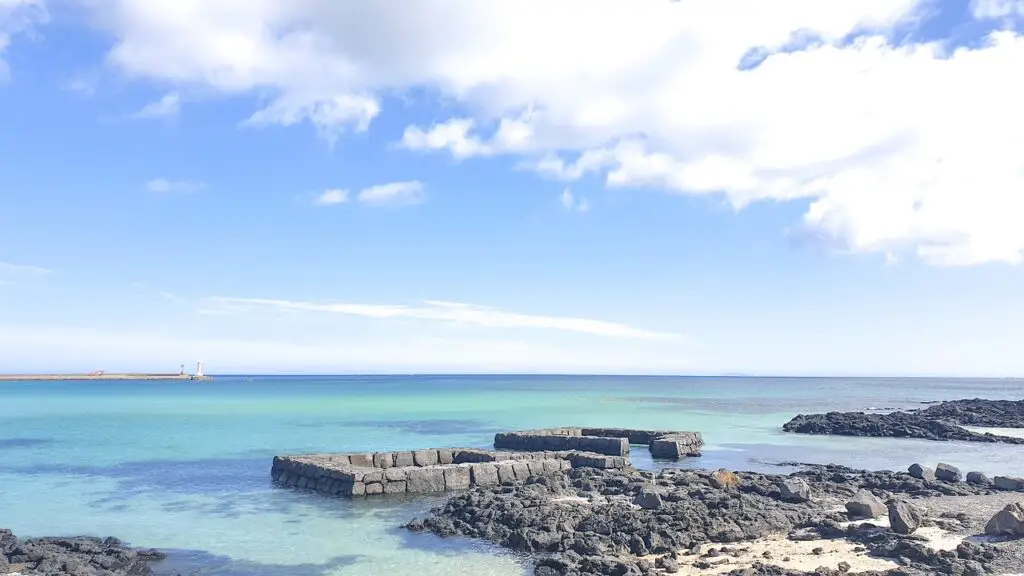
Welcome to Jeju, a paradise of natural beauty and cultural riches! Immerse yourself in the awe-inspiring landscapes, savory delights, and rich traditions this enchanting island has to offer. Discover the must-visit attractions and hidden gems with our meticulously crafted 6-day itinerary. I’m sharing itinerary, which is recommended by Jeju city. The attractions are listed in order of their proximity, ensuring an efficient use of time. Let’s jump right in!
| Day 1 | Places | Timeline | Distance |
| 1 | Cheonjiyeon Falls | 14:00 | |
| 2 | Soesokkak Estuary | 16:00 | ↩40.91 km |
| 3 | Manjanggul Lava Tube (UNESCO World Natural Heritage) | 16:00 | ↩37.40 km |
| 4 | Woljeong-ri Beach | 18:00 | |
| Day 2 | |||
| 1 | Yongduam Rock | 9:00 | |
| 2 | Monsant Café Aewol | 15:00 | ↩19.64 km |
| 3 | Hyeopjae Beach | 17:00 | ↩10.06 km |
| 4 | Neulbom Black Pork | 19:00 | ↩23.63 km |
| 5 | Jeju Dongmun Traditional Market | 20:00 | ↩7.6 km |
| Day 3 | |||
| 1 | Hallasan Mountain | 6:00 | |
| 2 | Cheonjiyeon Falls | 16:00 | ↩13.07 km |
| 3 | Jeongbang Falls | 17:00 | ↩2.5 km |
| 4 | Seogwipo Maeil Olle Market | 21:00 | ↩0.81 km |
| Day4 | |||
| 1 | Seogwipo Maeil Olle Market | 5:00 | |
| 2 | O’sulloc Tea Museum | 9:00 | ↩26.25 km |
| 3 | Norimae Park | 11:00 | ↩2.66 km |
| 4 | Sanbangsan Mountain Carbonate Hot Springs | 13:00 | ↩3.92 km |
| 5 | Songaksan Mountain | 16:00 | ↩4.61 km |
| 6 | Jeju Glass Museum | 17:00 | ↩15 km |
| 7 | Seogwipo Maeil Olle Market | 22:00 | ↩18.34 km |
| Day5 | |||
| 1 | Seogwipo Maeil Olle Market | 5:00 | |
| 2 | Seongsan Sunrise (Ilchulbong) Peak (UNESCO World Natural Heritage) | 06:00 | ↩47 km |
| 3 | Seopjikoji | 08:00 | ↩3.60 km |
| 4 | Hueree Natural Park | 12:00 | ↩30.43 km |
| 5 | Soesokkak Estuary | 14:00 | ↩6.35 km |
| 6 | Seogwipo Maeil Olle Market | 22:00 | ↩5.50 km |
| Day6 | |||
| 1 | Seogwipo Maeil Olle Market | 5:00 | |
| 2 | Jeju Dongmun Traditional Market | 9:00 | ↩29.49 km |
| 3 | Jeju International Airport | 11:00 | ↩2.92 km |
Day 1: Begin your journey with the mesmerizing beauty of Cheonjiyeon Falls and the serene ambiance of Soesokkak Estuary. Explore the stunning Manjanggul Lava Tube, a natural wonder recognized by UNESCO, before unwinding on the picturesque Woljeong-ri Beach.
Cheonjiyeon Falls
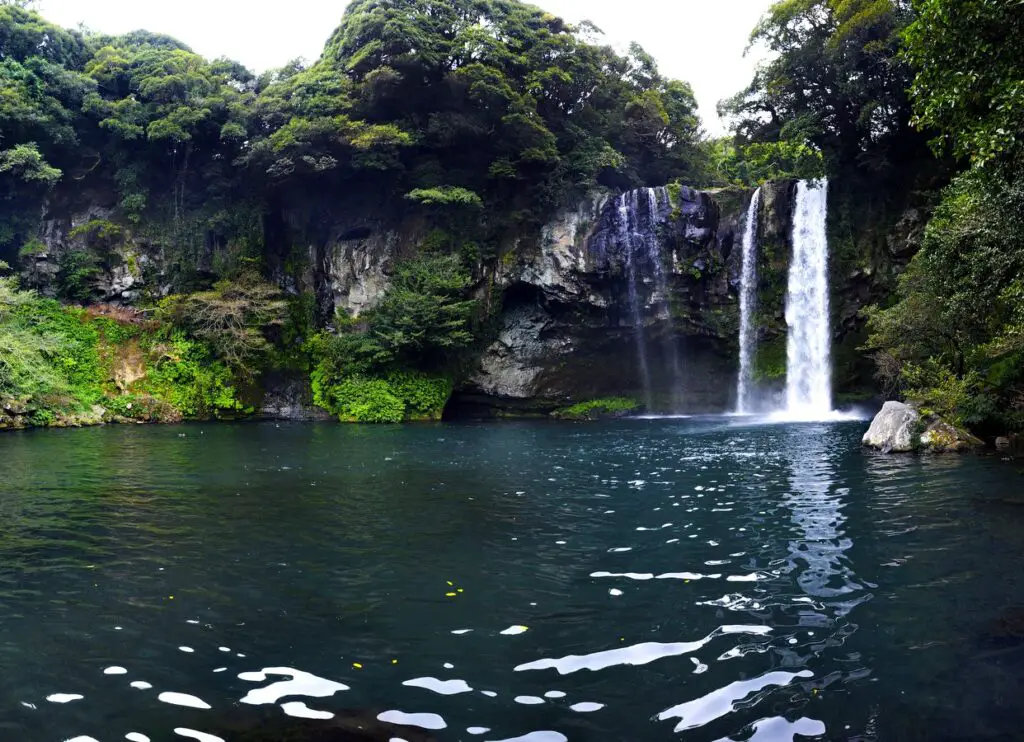
Address: 2-15, Namseongjung-ro, Seogwipo-si, Jeju-do, Korea
Contact: (+82) 064-733-1528
Cheonjiyeon Falls presents a magnificent spectacle as white water cascades down a rock cliff, creating a resounding thunder. Its name, which means “sky connected with land,” perfectly captures the harmony between nature and the heavens. Standing 22 meters high and 12 meters wide, the falls offer an awe-inspiring view and the soothing sound of falling waters.
In addition to the splendor of Cheonjiyeon Falls, the surrounding valley is adorned with various temperate plants, including Elaeocarpus, which holds the distinction of being Natural Monument 163. This area is also famed for being the natural habitat of Giant Mottled Eels, designated as Natural Monument 27, making it a fascinating spot for wildlife enthusiasts.
Notably, a recent phenomenon at Cheonjiyeon Falls has caught the attention of many visitors—a reflection of a rock resembling a human face. This captivating illusion appears when the water’s surface mirrors the rock, creating the impression of an adult’s face from one angle and a baby’s face from another. The best time to witness this fascinating sight is during the afternoon when the sun’s gentle glow enhances the effect.
Soesokkak Estuary
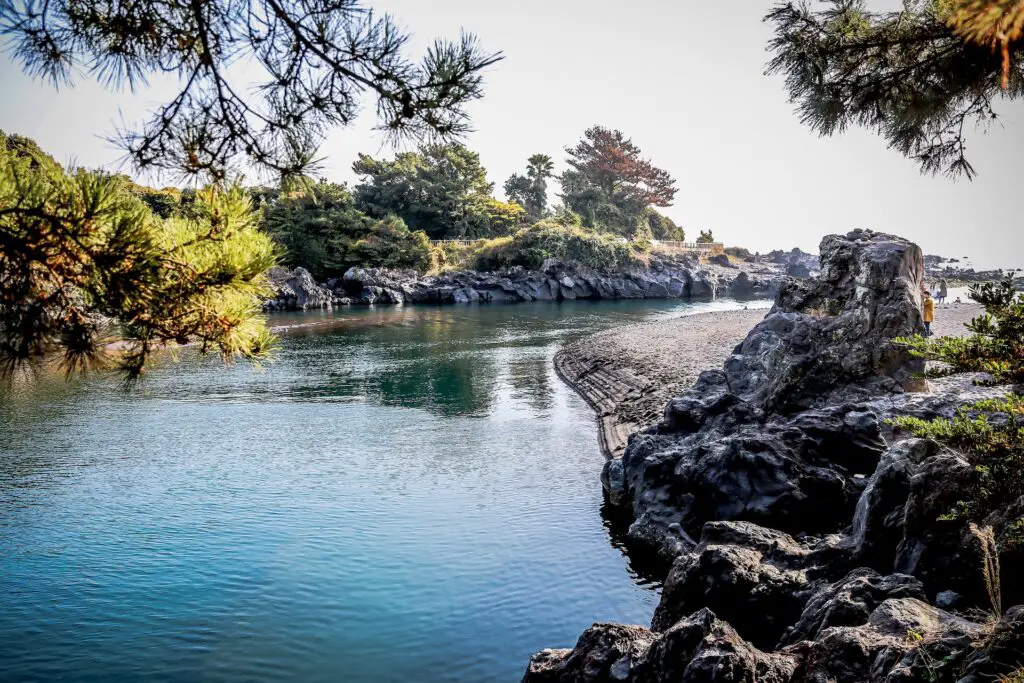
Address: Hahyo-dong, Seogwipo-si, Jeju-do
Contact (+82) 064-732-1562
Soesokkak Estuary, located at Hahyo-dong, Seogwipo-si, Jeju-do, used to be called “Soedun” because it looked like a cow lying down. But the name was changed due to the creation of a deep puddle that was formed from freshwater from Hyodoncheon Stream and saltwater. The “Soe” in “Soesokkak” means cow in Korean, while “So” means puddle and “Kkak” means the edge. Soesokkak Estuary is a valley formed by the flow of lava, and its geography is just as unique and interesting as its name implies. It is also one of the “Hidden Sceneries of Seogwipo Chilsimni,” and the harmonious view of strange rock formations and pine tree forests is visually stunning. There is also a famous raft called “Teu,” which you can ride on to admire every nook and corner of Soesokkak Estuary. On the raft, you pull the rope to pass through the crystal clear water, letting you enjoy the exotic view of the interesting array of rocks.
Manjanggul Lava Tube
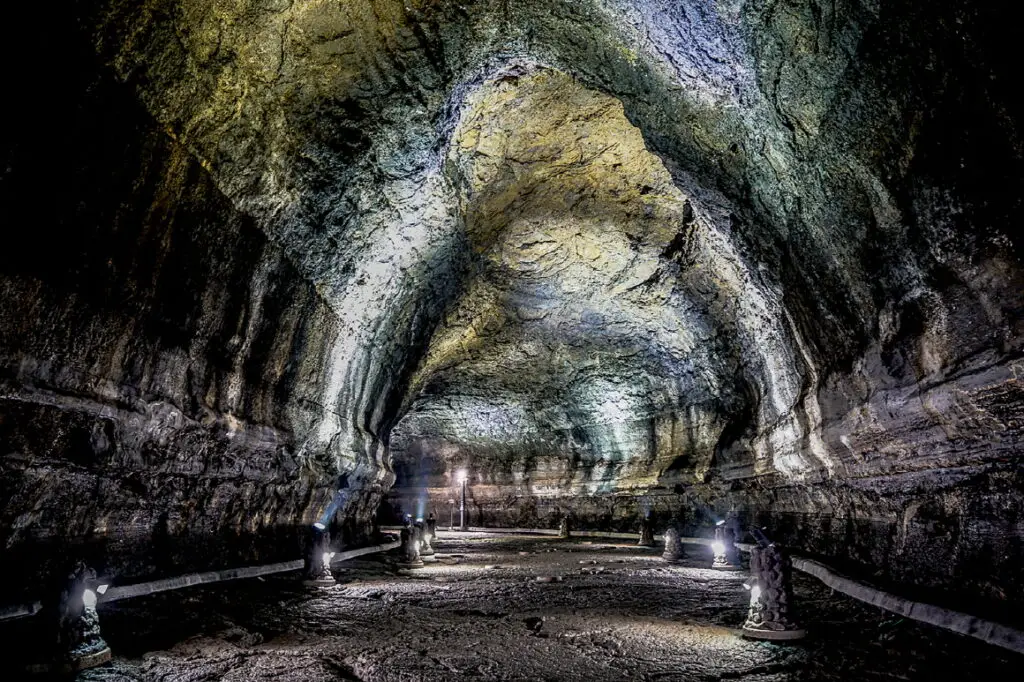
Contact: (+82) 064-710-7903
Manjanggul Lava Tube, with a total length of approximately 7.4 kilometers, is a partially multilayered volcanic tube—one of the largest of its kind globally. The main tunnel boasts an impressive width of 18 meters and a height of 23 meters, making it a significant site for researchers and scientists due to its well-preserved nature dating back thousands of years.
The tunnel is accessible through three entrances, with tourists allowed to venture up to 1 kilometer inside through the second entrance. As you explore the lava tube, marvel at the diverse cave formations, including stalactites, stalagmites, flowstones, lava tubes, lava shelves, and lava rafts. The highlight is the lava column, standing tall at 7.6 meters—the highest known lava column worldwide.
Woljeong-ri Beach
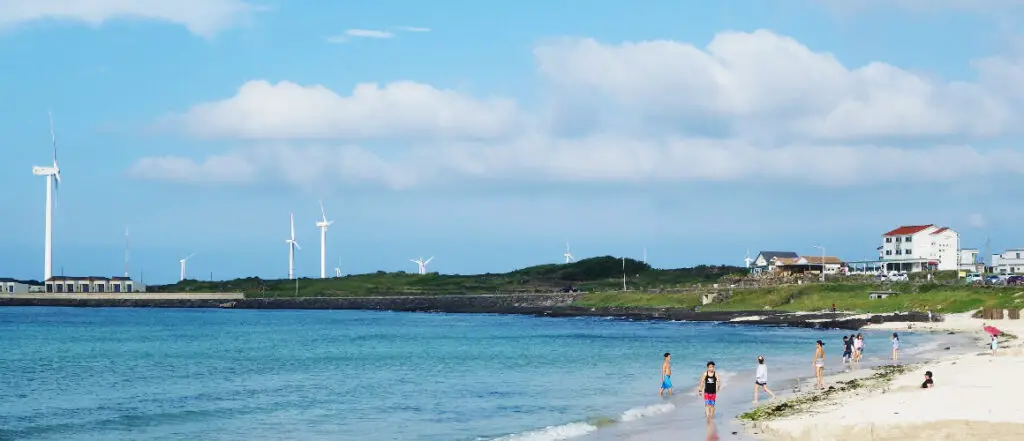
Address: 33-3, Woljeong-ri, Gujwa-eup, Jeju-si, Jeju-do
Contact: (+82) 064-783-5798
Nestled amidst stunning scenery, Jeju Woljeong-ri Beach boasts pristine white sands and emerald waters, creating a mesmerizing view, especially during low tide when Biyangdo Island drifts in the distance. The translucent blue water gives an illusion that the island is reachable on foot.
As you stroll along the beach, a road lined with tea houses and coffee shops provides the perfect setting for a relaxing stopover and a chance to indulge in an exotic view.
Day 2: Witness the majestic Yongduam Rock and indulge in delightful treats at Monsant Café Aewol. Relax at Hyeopjae Beach and savor the flavors of Neulbom Black Pork before exploring the vibrant atmosphere of Jeju Dongmun Traditional Market.
Yongduam Rock
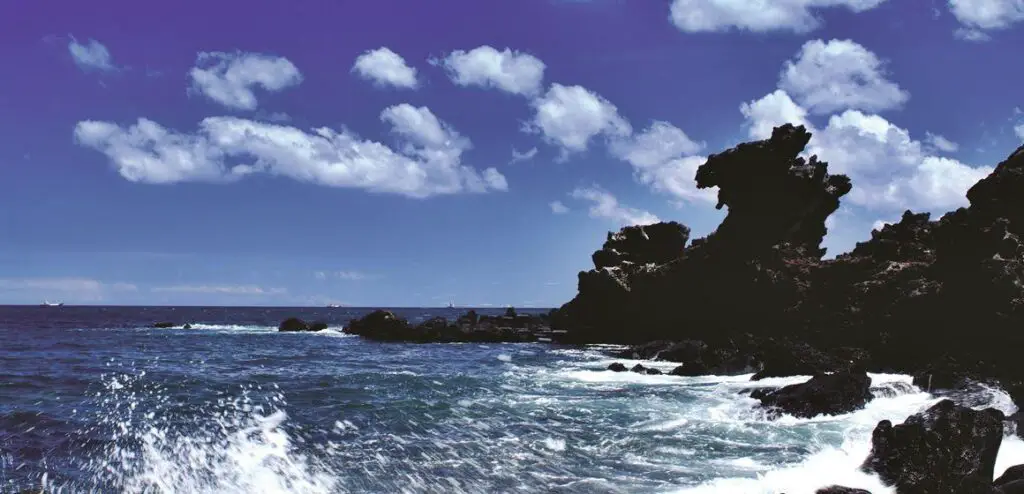
Address: Yongdam-ro, Jeju-si, Jeju-do
Contact: (+82) 064-728-3917
Yongduam Rock, also known as the Dragon Head Rock, serves as a symbol of a dragon’s unfulfilled dream. According to a local legend, a dragon residing in the underwater palace yearned to ascend to the heavens, an endeavor that proved challenging. To achieve its dream, the dragon discovered that it could reach the skies by grasping the orb of the Hallasan Mountain God. However, the dragon’s ambitious plan was thwarted when it was caught while hiding under Yongyeon Valley. In its moment of anguish and resentment, the dragon transformed into a rock.
True to its name, Yongduam Rock resembles a roaring dragon, seemingly emerging from the ocean’s depths. When the wind and waves are fierce, it appears as though the dragon might take flight into the sky. Standing 10 meters above water, with an additional 30 meters submerged, this remarkable rock formation has become one of Jeju Island’s most iconic landmarks.
For a mesmerizing experience, visit Yongduam Rock during sunset, when the dragon seems to writhe amidst the colors of the sky. To capture the best view of the rock, position yourself about 100 meters west of the site. Notably, Yongduam Rock is conveniently located just 200 meters west of Yongyeon Valley, another must-visit destination situated in the heart of downtown Jeju City.
Hyeopjae Beach
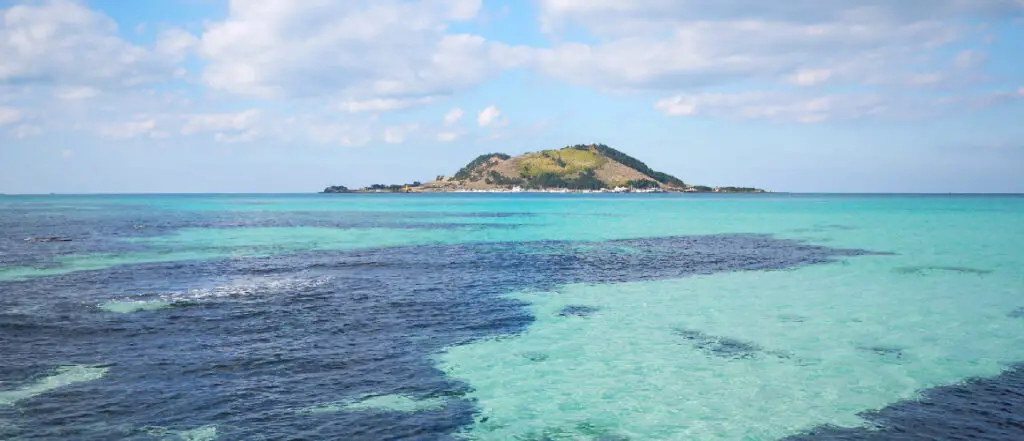
Address: 329-10 Hyeopjae-gil, Hallim-eup, Jeju-si, Jeju-do
Contact: (+82) 064-728-3981
Hyeopjae Beach lures visitors with its pristine waters and powdery white sands adorned with broken shells. As you wander along this picturesque shoreline, be captivated by the stunning view of low tide, with the scenic Biyangdo Island floating in the distance. The azure translucent waters create the illusion that one could almost walk to the nearby island.
This year, the beach has extended its allure to the nighttime, making it an enticing destination to visit even after sunset. Embrace the beauty of Hyeopjae Beach under the moonlit sky, offering yet another magical experience for tourists.
Jeju Dongmun Traditional Market
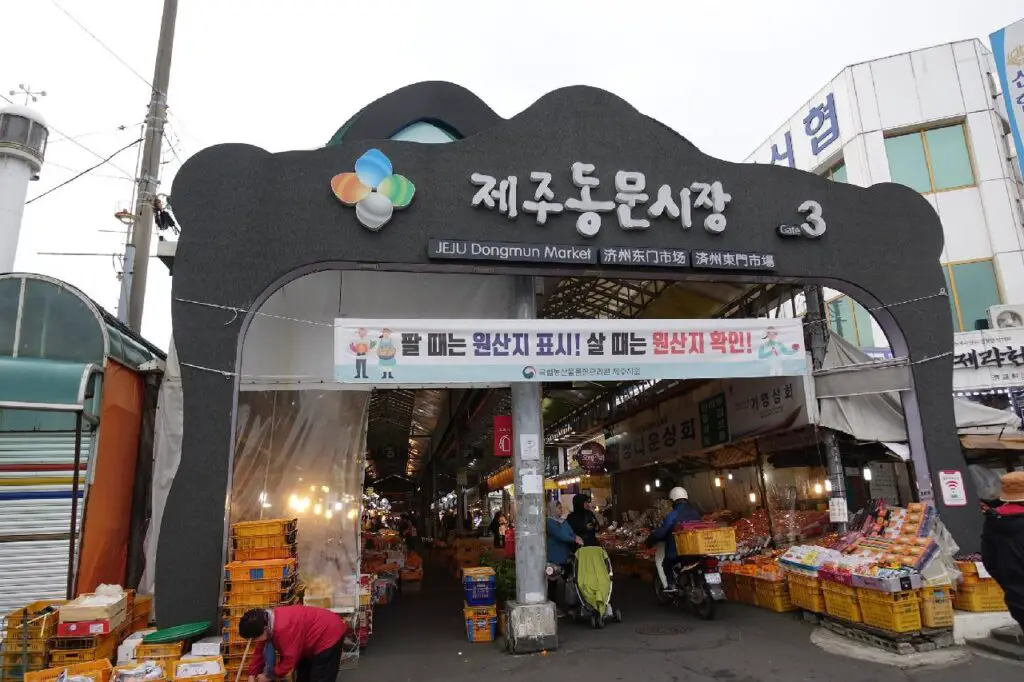
Contact: (+82) 064-752-3001
Jeju Dongmun Traditional Market stands as Jeju Island’s largest and oldest permanent market, drawing in visitors with its vibrant atmosphere and diverse offerings. Within this bustling marketplace, you’ll find a fusion of street markets, night markets, traditional markets, and seafood markets—all united in one vibrant location. This harmonious convergence makes it a popular destination among tourists eager to indulge in a variety of culinary delights and engage in delightful shopping experiences.
Day 3: Conquer the iconic Hallasan Mountain, the island’s highest peak, and experience the enchanting beauty of Cheonjiyeon and Jeongbang Falls. Wander through Seogwipo Maeil Olle Market to savor local delicacies.
Hallasan Mountain
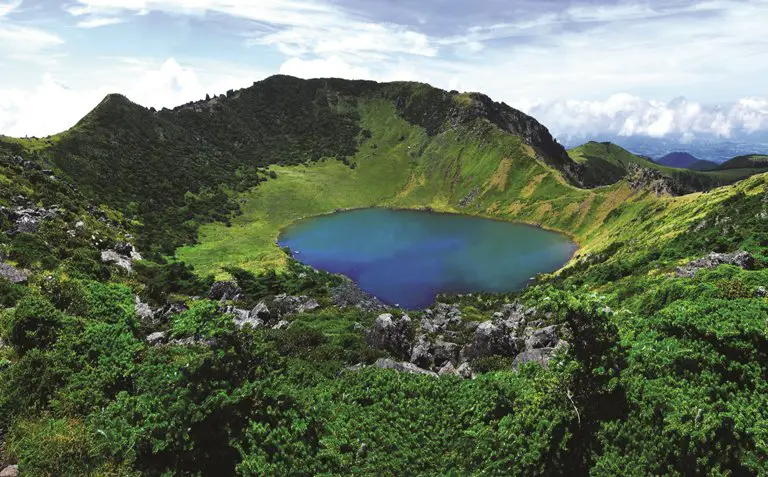
Address: 2070-61, 1100-ro, Jeju-si, Jeju-do
Contact: (+82) 064-713-9950
Hallasan Mountain, one of Korea’s three spirit mountains, stands proudly on the southernmost part of the Korean Peninsula. With a towering height of 1,950 meters above sea level, it claims the title of South Korea’s tallest mountain. Embracing a treasure trove of diverse flora and fauna, this majestic mountain was designated as Natural Monument 182 on October 12, 1966, and later recognized as a UNESCO Biosphere Reserve in December 2002.
In autumn, Hallasan Mountain transforms into a vibrant canvas as colorful flowers blanket its slopes. The mountain’s fiery red foliage during fall and its striking snow-covered peak in winter leave visitors in awe. With its rich geological history and unique volcanic formations, Hallasan Mountain presents an ever-changing tapestry of nature’s wonders throughout the seasons.
Jeongbang Falls
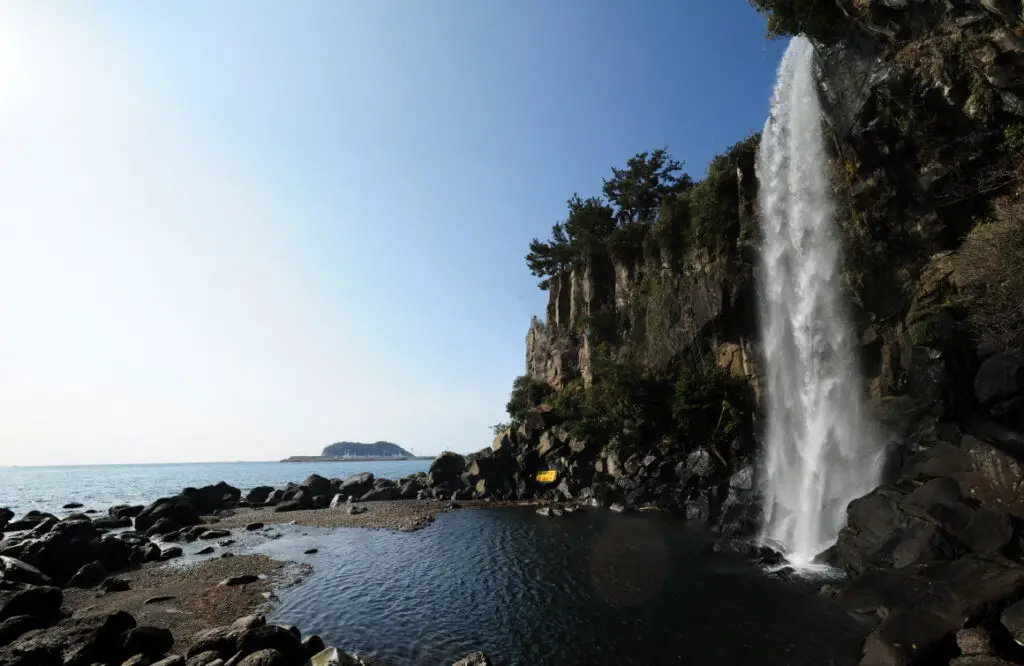
Address: 36, Chilsimni-ro 214beon-gil, Seogwipo-si, Jeju-do
Contact (+82) 064-733-1530
Jeongbang Falls is one of the Jejudo Island’s top 3 falls, along with Cheonjiyeon Falls and Cheonjeyeon Falls. It is the only fall in Korea where water falls directly into the sea. The fall is 23m high, and the two streams of waterfall that fall down the black cliff create a thrilling sound and a wonderful view. Moreover, the steep cliffs and old pine trees around the fall create a picturesque view, and this view was chosen as one of Ten Scenic Sights of Yeongju with the name of “Jeongbanghapok.” According to legends, a man named Seobul came to the island in search of an elixir plant on the orders of China’s Qin Shu Huangdi a long time ago. Unable to find the elixir plant, he headed west to return to China, and became captivated by the site of Jeongbang Falls, leading to him writing “Seobulgwacha’ on the cliff. However, these words have yet to be found in real life. It takes approximately 5 minutes to go down the stairs leading from the parking lot to the fall.
Seogwipo Maeil Olle Market
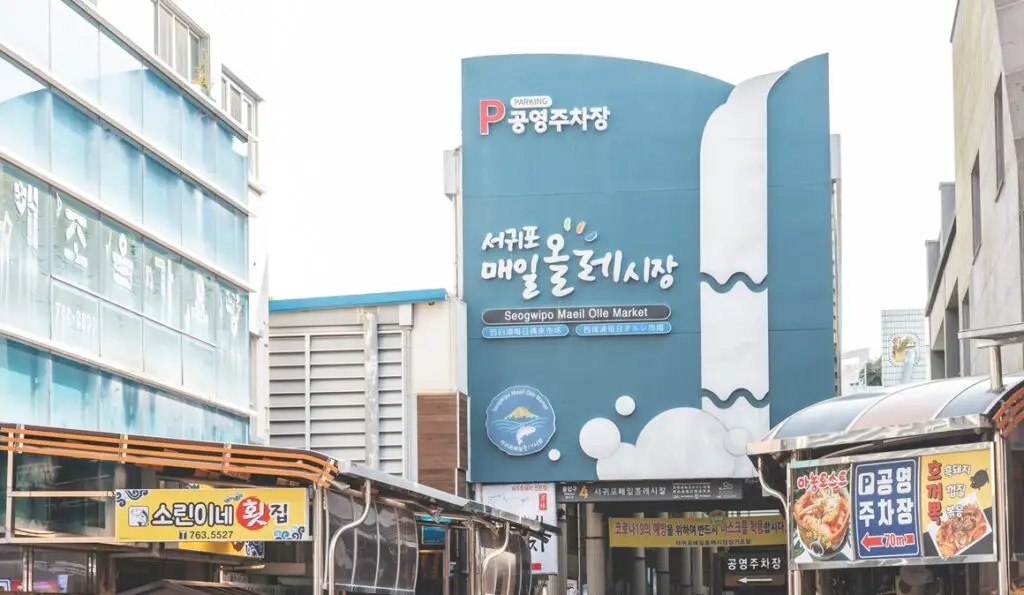
Day 4: Delve into tea culture at O’sulloc Tea Museum and unwind at Norimae Park. Experience rejuvenation at Sanbangsan Mountain Carbonate Hot Springs and immerse yourself in the scenic allure of Songaksan Mountain. Discover the captivating artistry at Jeju Glass Museum before returning to Seogwipo Maeil Olle Market.
O’sulloc Tea Museum
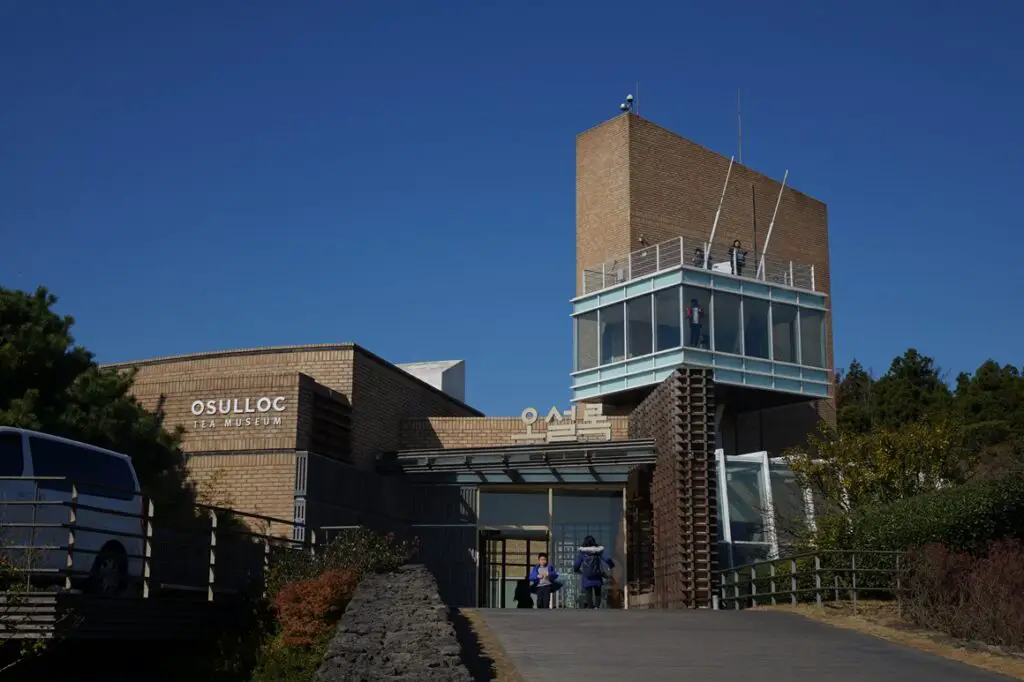
Address: 425, Sinhwayeoksa-ro, Andeok-myeon, Seogwipo-si
Contact: (+82) 064-794-5312
Web: https://www.osulloc.com/kr/ko/museum
O’sulloc opened on Sept. 1, 2001, and is located at the entrance of Seogwang Tea Garden in Jeju Island. It has since become a major attraction, with visitors coming from all over to enjoy the green panoramic tea fields in which to take many great photos. You can also buy loose teas and related products, including delicious green tea ice cream! The building itself is the materialization of a green tea cup, a place where tradition and modern east and west are harmonized, and a nature-friendly resting area.
Norimae Park
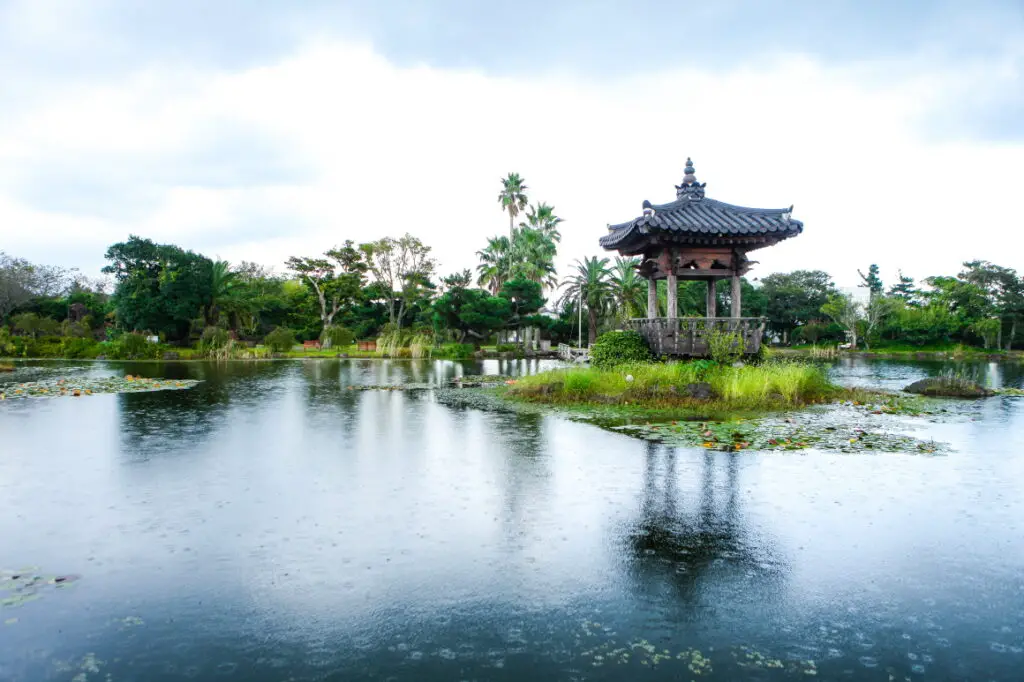
Address: 2260-15, Jungsanganseo-ro, Daejeong-eup, Seogwipo-si, Jeju-do, Republic of Korea
Contact: (+82) 064-792-8211
Web: www.norimae.com
Norimae Park offers an all-season flower-themed oasis, perfect for relaxation and capturing unforgettable moments through photography. This tranquil park sets the stage for creating cherished memories, especially for outdoor wedding photos. Immerse yourself in the beauty of nature and bask in the serenity that this hidden gem has to offer.
Sanbangsan Mountain Carbonate Hot Springs
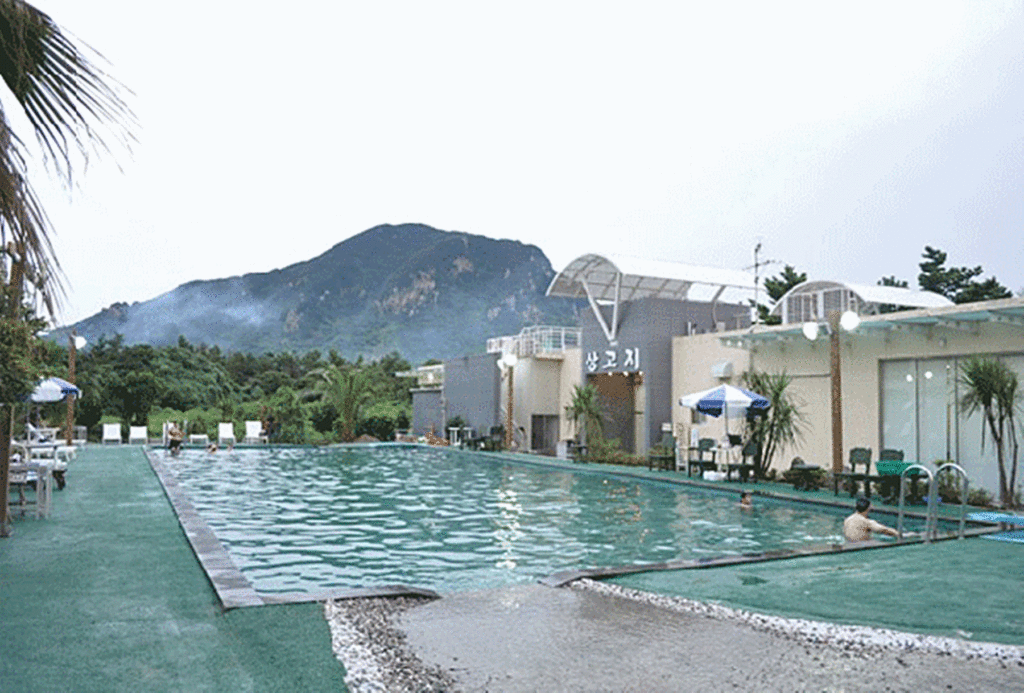
Contact: (+82) 064-792-8300
Indulge in the ultimate relaxation at the Jeju Carbonate Hot Spring, where the pH level impressively measures 6.58, indicating its neutrality. Nestled 600 meters underground, the spring boasts a bottomhole temperature of 32.55°C, discharging water at 31°C. This exceptional hot spring stands out by offering five times more major components, such as free carbon dioxide, bicarbonate ion, and sodium, compared to other carbonate hot springs in Korea. The remarkable water quality is reflected in the absence of colon bacterium, surpassing even the five major mineral springs in Korea. Soothe your senses and rejuvenate in the rejuvenating embrace of this unique hot spring.
Songaksan Mountain
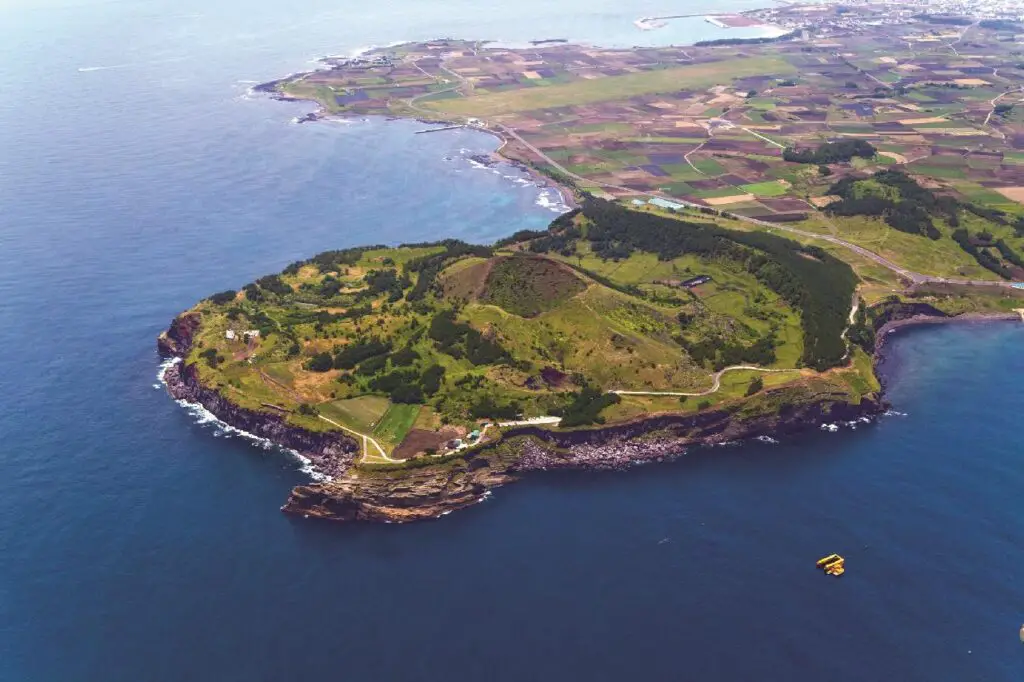
Address: 421-1, Songakgwangwang-ro, Daejeong-eup, Seogwipo-si, Jeju-do
Contact: (+82) (Contact for information)
Songaksan Mountain, a geological marvel, features a cinder cone at its center, surrounded by a tuff ring. Its peak, often likened to a mouth, delves 69 meters deep and remarkably preserves its active form. Although previously obscure and known only to archaeology enthusiasts, the mountain now forms part of well-known tour courses, attracting adventurers through a network of narrow paths. This historic site once served as Japan’s forward operating base during the invasion of China and acted as the last line of defense in WWII. The remnants of airfields, hangars, and anti-aircraft artillery add to the site’s intrigue, while coastal trenches below the cliff offer stunning ocean views. Witness the captivating landscape, framed by Hyeongjeseom Island, Gapado Island, and Marado Island, providing a backdrop for breathtaking photographs and unforgettable memories.
Jeju Glass Museum
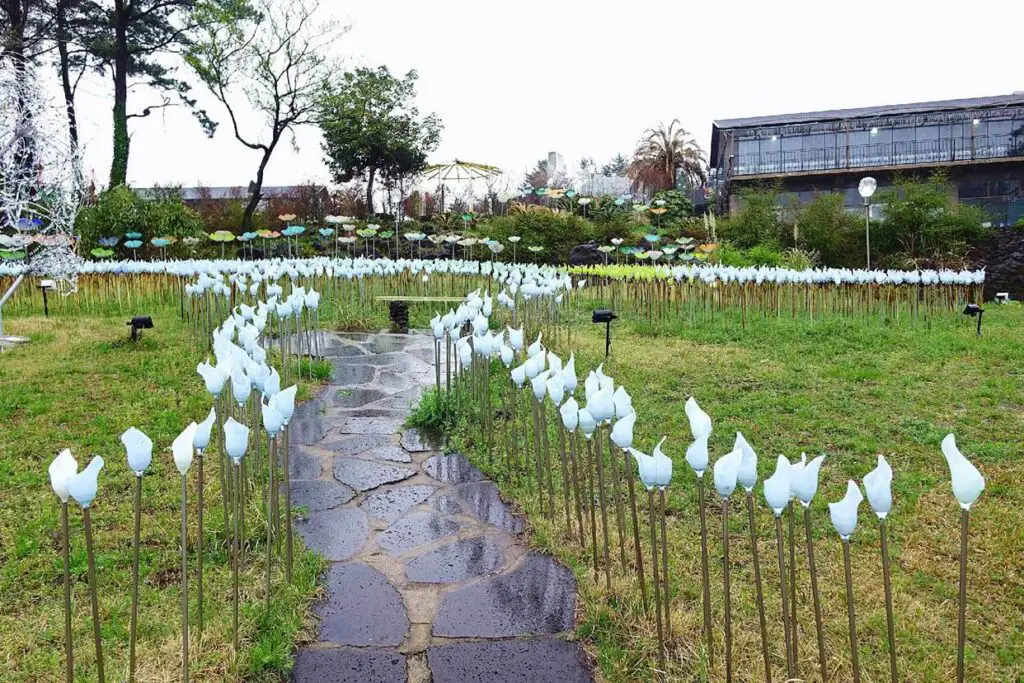
Contact: (+82) 064-792-6262~3
Web: http://www.glassmuseum.co.kr/main.php
Step into a realm of transparent beauty at the Jeju Glass Museum, the only glass museum in Korea. Nestled within a secret garden amidst the forest, this museum showcases exquisite glass artworks that harmonize with Jeju’s natural surroundings across a vast 26,444㎡ land. Tucked away from typical tourist routes, finding this hidden gem might challenge navigation systems, but the experience is worth the effort. The museum takes pride in featuring glassworks crafted by professional glass artists, rather than commercially sourced pieces. Marvel at the interplay of glass and nature, a captivating sight that will mesmerize every visitor.
Day 5: Greet the sunrise at Seongsan Sunrise (Ilchulbong) Peak, another UNESCO gem, and explore the scenic landscapes of Seopjikoji. Admire the natural wonders at Hueree Natural Park and revisit the tranquility of Soesokkak Estuary.
Seongsan Sunrise (Ilchulbong) Peak
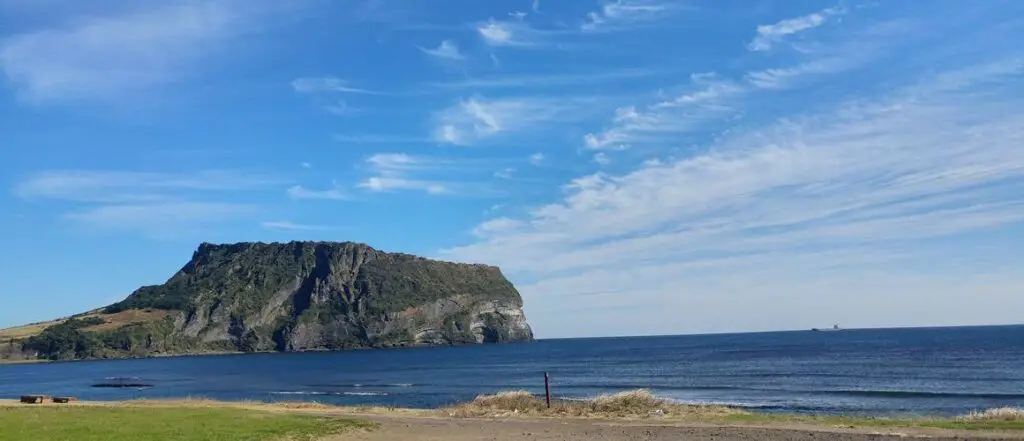
Address284-12, Ilchul-ro, Seongsan-eup, Seogwipo-si, Jeju-do
Contact(+82) 064-783-0959
Seongsan Ilchulbong Peak is 180m above sea level and erupted underwater in the ocean about 5,000 years ago. This makes it a very rare case among the many craters in Jeju Island. Though people used to farm in the crater, it is now a natural habitat for 200 types of vegetation such as silvergrass and giant angelica, among others, as well as a natural habitat for a variety of wild animals. In popular culture, a scene in the movie ‘Lee Chang-ho’s Baseball Team’ (directed by Lee Chang-ho) was filmed here. Seongsan Ilchulbong is a protected area that is the pride both of Jeju residents and citizens of Korea. It was designated a Natural Monument on July 19, 2000, and subsequently recognized for its outstanding geological value by UNESCO on July 2, 2007, when it was added to the World Natural Heritage List. The peak was also named a Global Geopark Network site in October 2010.
Seopjikoji
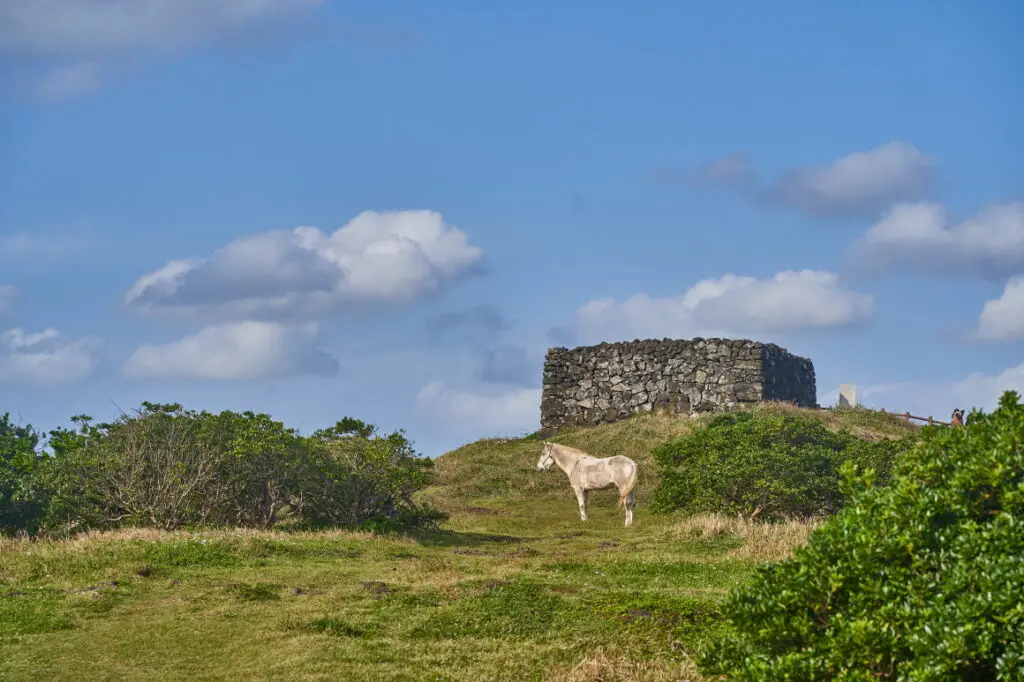
Address: Seopjikoji-ro, Seongsan-eup, Seogwipo-si, Jeju-do
Contact: (+82) 064-740-6000
Seopjikoji, located on the east coast of Jeju Special Self-Governing Province, is a breathtaking coastline that comes to life during spring with vibrant canola flowers adorning the hills. With the iconic Seongsan Ilchulbong Peak in the background and the mesmerizing Sinyang Beach nearby, Seopjikoji offers a stunning fusion of natural wonders.
This picturesque site showcases the traditional beauty of Jeju, from vast lands carpeted with canola flowers to peaceful Jeju ponies grazing leisurely. The landscape also features beautiful rocky cliffs and the legendary Seonbawi Rock standing majestically in the middle of the ocean.
Unlike other coasts on Jejudo Island, Seopjikoji is made of red volcanic ash known as “scoria” and boasts peculiar rock formations that only reveal themselves during low tide, making it truly unique.
Seopjikoji’s scenic allure has captured the hearts of filmmakers, making it a sought-after filming location for movies and TV dramas like “The Legend of Gingko,” “The Uprising,” “Cheonilya,” and “All In.” The picturesque blue house at the sea, featured in the movie “The Legend of Gingko,” was inspired by this very location, drawing tourists from far and wide.
Hueree Natural Park
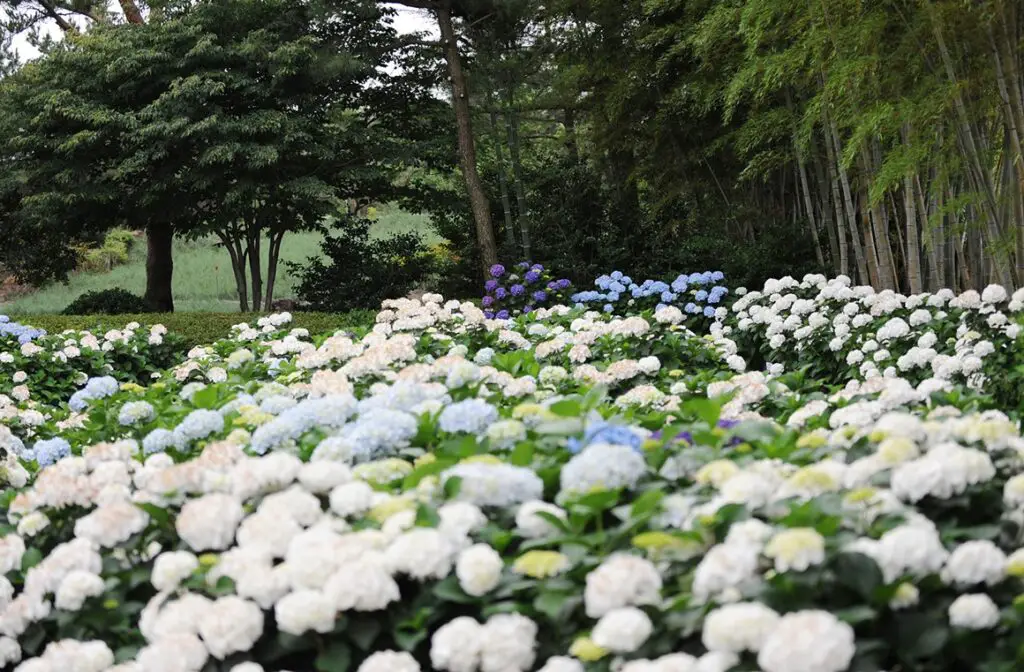
Contact: (+82) 064-732-2114
Web: www.hueree.com/
Hueree Natural Park is a quintessential Jeju-like and locally cherished park, aptly described as a little Jeju within Jeju. Nestled at the foot of Hallasan Mountain, this natural life experience park invites visitors to rejuvenate their weary hearts through leisurely walks along the Jeju Olle trails.
While exploring the park, delight in the endearing sight of black pigs performing cute tricks, adding a touch of charm to the serene surroundings. Hueree Natural Park offers an authentic taste of Jeju’s beauty and culture, providing a delightful escape from the hustle and bustle of city life.
Day 6: Embark on a final exploration of Jeju Dongmun Traditional Market, where cultural riches await. Bid farewell to the island as you head to Jeju International Airport, cherishing the memories of an unforgettable journey.
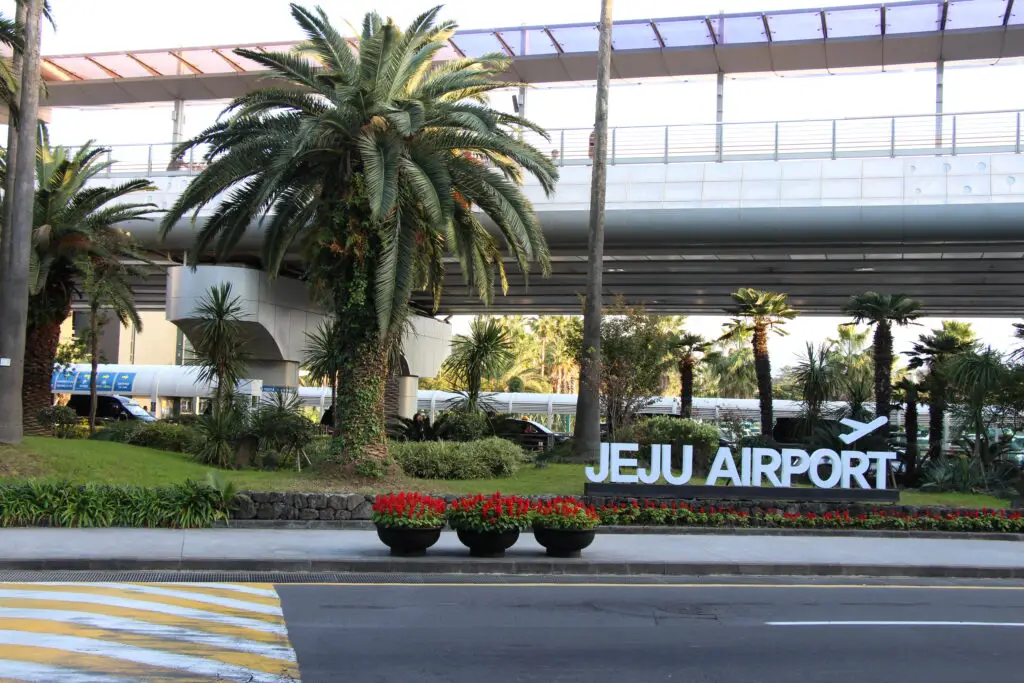
Discover the allure of Jeju with our comprehensive itinerary, ensuring you experience the essence of this captivating island. From natural wonders to cultural marvels, Jeju has it all!
